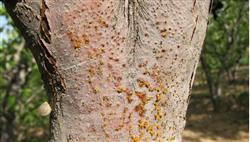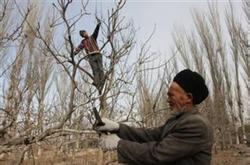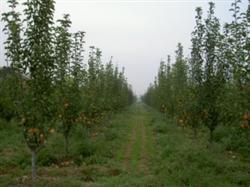Pear tree rot and its control

1. Disease prevention of strong trees: (1) reasonable burden: according to the growth status of the tree and the level of fertilization, determine the appropriate amount of fruit, do not let the tree bear too much, let alone take too many measures to increase fruit, such as branch pulling and ring peeling for short-term benefits. It is necessary to properly thinning flowers and fruits so that the fruit can grow without mistake. (2) increasing fertilizer and water: for the vast pear areas in the north, the more common phenomenon is the lack of fertilizer and water. In fertilization, we should pay attention to the application of organic fertilizer, phosphorus fertilizer, potassium fertilizer and trace element fertilizer, but not too much nitrogen fertilizer. (3) protecting leaves and promoting roots: timely control of diseases and insect pests that cause early fallen leaves, such as scab, gray spot, black spot, brown spot, red spiders, pear net bugs, aphids, leaf rollers, etc. At the same time, we should also pay attention to the prevention and control of various root diseases. two。 Avoid and protect the wound: (1) thoroughly control branch pests: Jiding, Spodoptera litura, longicorn beetles and other branch pests are not only the makers of wounds, but also the vectors to carry and spread germs. thorough control of these pests is very important to the vast pear area. (2) prevent frost injury and sunburn: the sunny side of the pear branch has a large temperature difference between day and night, so it is easy to suffer frost injury; if there is no leaf cover on each sunny side, the pear is easy to die from the sun in summer. The more effective measures to prevent frost damage are: first, the trunk is painted white to reduce the temperature difference between day and night; the other is that the trunk is bundled with grass to cover and prevent freezing. The formula of commonly used whitening agent is 12 kilograms of quicklime. Add 2 kg of stone-sulfur mixture (about 20 Baume), 2 kg of salt, 36 kg of water, or 10 kg of quicklime, 3-4 kg of soybean milk and 40-50 kg of water. Painting white can also prevent branches from burning in the sun. (3) to protect the wound: the larger saw blade should be cut flat, and then protected by tung oil, varnish or Topurazine ointment, Smur921 antibacterial agent and so on. After the larger lesion is cured, it should be bridged and protected in time. 3. Timely treatment of disease spots: (1) scraping bark: scraping off warped bark and necrotic tissue before pear sprouting, scraping combined with spraying or spraying. It can be sprayed with 300-fold solution of 50% formearsine wettable powder, or 1% 3-degree stone-sulfur mixture. (2) Drug treatment of lesions: after scraping off the diseased tissue, evenly smear the disease part with 1 part of 70% methyl Topurazine powder plus 2.5 parts of vegetable oil, or 1 part of 50% carbendazim wettable powder plus 1.5 parts of vegetable oil. It can also be smeared with Baume 5-10-degree stone sulfur mixture, Smur921 antibiotic 20-fold 30-fold solution, 40% Fumet arsine 50-fold solution or 30% decaying enemy 30-fold solution, 843 rehabilitation agent original solution, Wuningmycin fermentation broth 5 times liquid, etc., in order to prevent scar recurrence. The exposed xylem can be smeared with coal tar or antirust paint, and the disease scars on the larger trunk can be bridged in time to restore the tree potential as soon as possible. Scrape off the bark and diseased branches and burn them centrally.
- Prev

Improved trunk shape and simplified pruning of pear trees
The pear tree is an improved trunk with a height of 60-70 cm and a height of 3.5 m. There are 4-5 large main branches in the middle and lower part of the central leader's trunk. The distance between the main branches is about 20 cm. The base angle of the main branch is 60 degrees. The waist angle is 30-50 degrees. The tip angle is erect; the main branch extends uniaxially. It bears small and medium-sized fruiting branches or groups of branches; the ratio of main branches to trunk is controlled.
- Next

Management techniques of Pear trees in early Spring
1. Dig a fixed planting hole or planting ditch. The planting hole can be dug in the pear orchard where the plant distance of ① color tree species is more than 3 meters. The planting hole can be dug into a round or square planting pit with a depth of 1 meter and a width of 1 meter, and the topsoil and core soil can be placed on both sides of the hole. ② plant distance below 2 meters in the pear orchard, to dig a fixed planting ditch, ditch depth of 1 meter,.
Related
- Moge, come on! The staff of the peasant association in the producing area of cantaloupe were frightened when the crowd gathered.
- Causes and Solutions of low Fruit setting rate of Apple
- Symptoms and control measures of passion fruit virus disease
- Fruit growing lesson: how do apple orchards keep high yields?
- Can you build orchards in the mountains? What are the pros and cons?
- How to manage the coloring period of Crisson grape?
- This paper introduces the processing technology of two kinds of fig products.
- How much is a month for retired teachers in rural areas by 2020?
- How can strawberry planting increase sugar content? We should pay attention to management in many aspects.
- What are the cultivation techniques on how to improve the yield of golden fruit?

